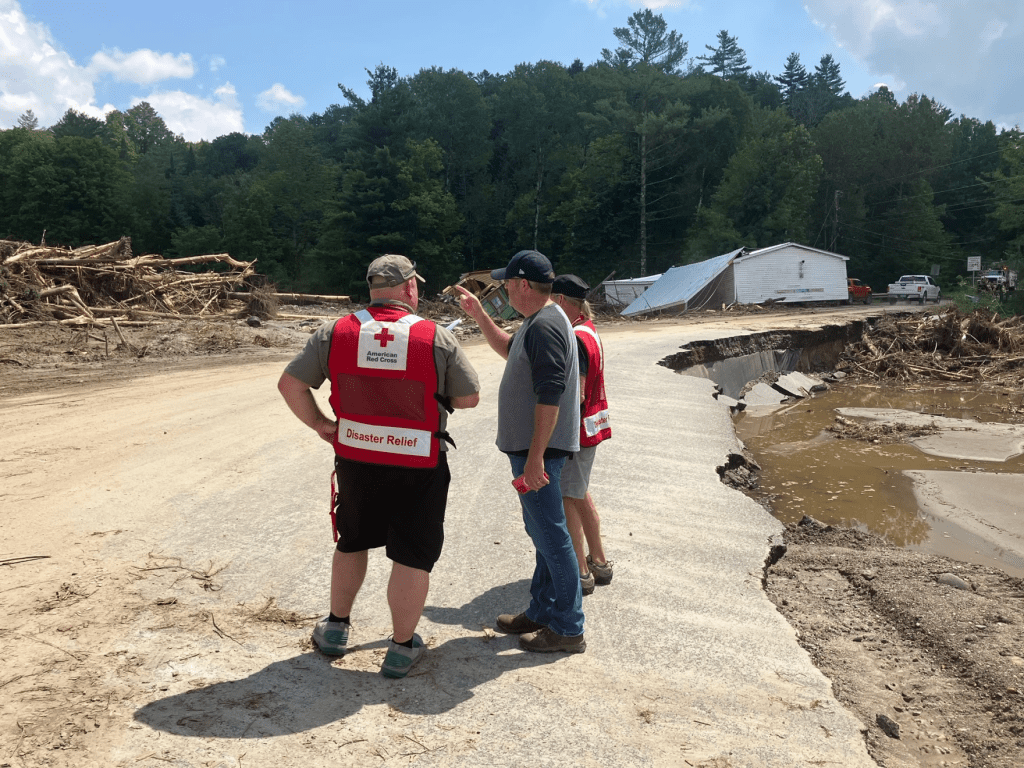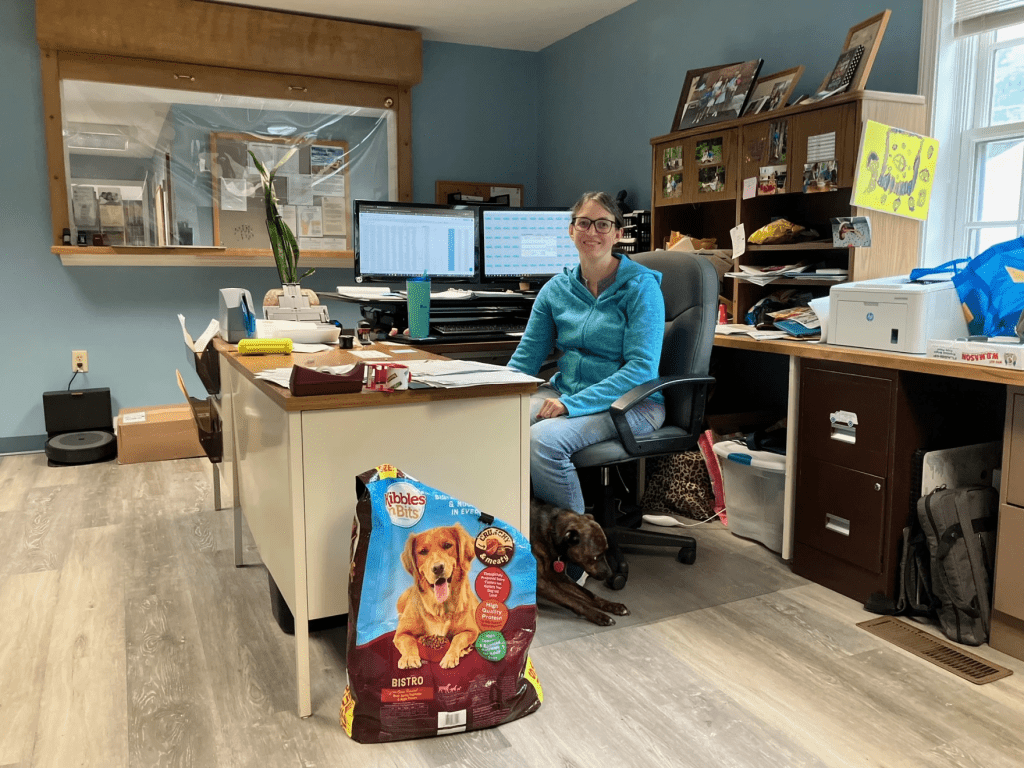
Peter Hirschfeld / Vermont Public
In early August, Justin Smith watched excavators get to work on a nearly quarter-mile washout at the bottom of Red Village Road in Lyndonville.
Scores of residents had been isolated in their homes by a flash flood that took out more than a half dozen sections of the town road about 48 hours earlier. As Lyndon’s municipal administrator, it was Smith’s job to figure out a way to get them out.
But there was a problem.
“We’re at that point where the purse is pretty much dry,” Smith told Vermont Public last month. “And we don’t have any liquidity anymore where we can pay [for] things.”

Peter Hirschfeld / Vermont Public
The purse was dry, Smith said, because Lyndon still hadn’t received any money from the Federal Emergency Management Agency for the floods that devastated this Northeast Kingdom town last year.
“I went through four administrators with FEMA in four months … I had to do the paperwork four times. I did it on forms that they gave me and then told me were not the correct forms, and it’s just a walkaround and it hasn’t been a fun process, to be honest with you,” Smith said. “It shouldn’t be this hard. And I still don’t have anything that I can pay a bill with.”
Lyndon is not an outlier. Towns in at least five counties that were part of the 2023 federal disaster declaration have yet to get reimbursed from FEMA for catastrophic damage to critical infrastructure. According to FEMA’s own numbers, nearly 60% of public assistance requests submitted by towns had yet to be approved as of Sept. 6.
Never before have I woken up at 3 a.m. and worried about where the money’s coming from, but I do it now.
Kristin Atwood, Barton Town Clerk
Sen. Peter Welch said in a recent interview that FEMA is supposed to perform one of the sacred duties of government.
“When a disaster hurts fellow citizens — they have a fire, they have a flood, they have a tornado — we have to come to the aid of our fellow citizens,” Welch said. “And that’s what FEMA, as an instrument of government, that’s its responsibility.”
Welch said the Federal Emergency Management Agency has failed to uphold that obligation.
“The almost universal experience I’ve seen with our towns on public assistance is immense frustration about getting timely decisions from FEMA to proceed with a project,” he said.
Earlier this summer, Vermont Public published a report that spotlighted systemic failures in FEMA’s individual assistance program for flood survivors. A subsequent investigation, which includes interviews with town clerks, select board members and other municipal officials, shows structural problems in the agency’s public assistance program as well.

Peter Hirschfeld / Vermont Public
That program is supposed to reimburse municipalities for no less than 75% of the cost to rebuild roads, bridges, wastewater systems and other public infrastructure that’s been damaged or destroyed in a disaster. More than a year after last summer’s floods, however, FEMA assistance often isn’t getting to the towns that need it most. And the same federal bureaucracy that hampered flood recovery for individuals is plunging small, rural towns into crippling debt.
Vermont Public has learned that all three members of Vermont’s congressional delegation sent a formal letter to FEMA Administrator Deanne Criswell earlier this month calling for “long-term and structural” reform at the agency.
Vermonters’ experiences with FEMA in the aftermath of the summer floods of 2023, they write in the letter, “have caused immense concern, added expense, and despair for Vermonters doing their best to move on from catastrophic losses.”
“Homeowners, businesses, selectboards, farmers, and other stakeholders across Vermont have faced, and continue to face, delays, confusing and conflicting guidance, and inefficiencies in getting clear answers and timely responses from FEMA to predictable inquiries about what help they can expect and when they can expect it,” the delegation says.
Because of a delay in processing FEMA reimbursements, towns have to take out loans.
Ted Brady, Vermont League of Cities and Towns
FEMA declined to make someone available for an interview for this story. The agency said in a statement that, “The pace of delivery for FEMA’s Public Assistance program depends on many factors.”
“FEMA requests information and documentation for each Public Assistance project to support that its facilities, work, and costs are eligible based on the applicable laws, regulations, executive orders, and policies,” a FEMA spokesperson said in a written statement on background.
Frustration can be especially pronounced in small towns like Stannard, which has a population of 208 people and no paved roads.

Mike Dougherty / Vermont Public
“A little bit people still describe it as the wild west,” Stannard Select Board member Katy Knuth said. “I love this community. It’s great. But I think people might think part of it can be a little rough around the edges, in a wonderful and endearing way.”
Knuth has spent more hours than she can keep track of trying to obtain FEMA reimbursement for damage to Stannard Mountain Road, for example, where she stood on a spectacular afternoon in August.
“Coming into this, I had no clue what I was doing, and I’m sure there’s mistakes I’ve made along the way,” she said. “But the amount of back and forth about things is just ridiculous.”
Knuth assumed she’d send FEMA invoices for work that was directly related to flood recovery, and then they’d send her the money. Instead, she said the agency has withheld that funding until it gets more information about things such as the size of the rocks that Stannard’s one-person road crew used to rebuild the roads last year.
“The amount of times I’ve been asked for dimensions of pieces of riprap that are now in a road — I don’t know, to me that question is ridiculous. How do I measure something that’s been buried a year ago?” she said.
The more than $400,000 that Stannard is still waiting on is huge money for the municipality. And the line of credit town officials had to take out in the meantime is creating very real concerns about its solvency.
The amount of times I’ve been asked for dimensions of pieces of riprap that are now in a road — I don’t know, to me that question is ridiculous. How do I measure something that’s been buried a year ago?
Katy Knuth, Stannard Select Board member
Ted Brady, the executive director of the Vermont League of Cities and Towns, said flood-ravaged towns of all sizes are dealing with similar problems.
“Because of a delay in processing FEMA reimbursements, towns have to take out loans, towns have to take out tax anticipation notes,” Brady said. “Therefore, their budgets and taxpayers are paying interest that they otherwise wouldn’t need to pay.”
That lack of access to capital, Brady said, has begun to affect critical government functions.
“Because of the floods, there are less investments happening in regular paving projects,” he said. “Because of the floods, there are less investments happening in public safety. Because of the floods, there is less investment happening in water and wastewater infrastructure.”
Brady said the level of scrutiny that FEMA has applied to public assistance requests comes at significant costs to taxpayers — costs that offer no direct recovery benefits to the individuals and communities that FEMA was created support.
“Since July of 2023, hundreds of federal employees have landed in Vermont to audit and account for every penny of federal money that a town has asked for,” Brady said. “At what cost?”
Records obtained by Vermont Public earlier this summer show that FEMA had, as of March, incurred nearly $80 million in administrative costs on the recovery mission related to the floods from July of 2023. That same mission has disbursed a total of about $44 million in individual assistance to flood survivors. State officials estimate that Vermont will, eventually, receive around $600 million in total reimbursement for flood damage to publicly owned infrastructure.
The FEMA bureaucracy is so fraught and labor intensive that the state of Vermont has paid $4 million to a private contractor, based in Illinois, to help it, and towns, navigate the public assistance process.
“It’s so complex that even when the town works with the state public assistance coordinator at VEM (Vermont Emergency Management), they prepare exactly what FEMA asks them, it then gets kicked back later because someone else up the chain reviewing it has a question that the PDMG didn’t think to ask for an answer, because of the level of complexity,” said Douglas Farnham, Vermont’s chief recovery officer.
PDMG is FEMA-speak for something called a program delivery manager. They’re one of the FEMA employees that town clerks such as Kristin Atwood, in Barton, have to satisfy before they can gain access to public assistance funds.

Peter Hirschfeld / Vermont Public
“Never before have I woken up at 3 a.m. and worried about where the money’s coming from, but I do it now,” Atwood said in her town office last month. “My road foreman keeps calling me and saying, ‘Can I get this or that that I need?’ And I’m saying, ‘Yes,’ on faith instead of on numbers, because the numbers aren’t there to support me saying yes do that project. But it’s a project that’s really needed, so I’m just saying yes.”
Atwood said she’s spent hundreds of hours outside of regular office hours doing things like tracking down GPS coordinates of the start and end points of destroyed guardrails, and the precise spot of whatever junkyard they were sent to.
She’s had to calculate the cubic volume of cavernous road washouts, presumably, she said, so FEMA doesn’t pay for more yards of fill than is needed to fix them.
“I think there needs to be a return to a basic level of trust between levels of government. The town is not lying and saying we used this gravel for this project. We used this gravel for this project and I’m happy to send you the before and after photos and the invoice,” Atwood said.
The issue of program delivery managers is of special concerns to municipal officials and federal lawmakers who say rapid turnover rates among employees in these have delayed access to needed public assistance funds.
Ludlow, which saw some of the most severe flood damage to public infrastructure last year, has gone through seven program delivery managers since last July and is still waiting on $4 million in public assistance requests.
Vermont’s congressional delegation said the turnover rates have exacerbated a “bureaucratic backlog” as towns struggle to reconcile contradictory requests and requirements from the various FEMA personnel cycling through their communities.

April McCullum / Vermont Public
What Welch, Sen. Bernie Sanders and Rep. Becca Balint ultimately want, however, is a fundamental overhaul of the way FEMA administers its disaster-response mission, so that the responsibility for disbursing recovery funds falls to states, instead of a Washington, D.C.,-based bureaucracy.
“There is an appreciation that a local delivery model and that local decision-making model … is a much better way to go,” Welch told Vermont Public.
Barton Town Clerk Kristin Atwood said she’s finally won approval for about $1.3 million in public assistance projects there, though the town officials won’t be able to use those funds until they provide invoices for completed work.
She said she’s missed dinners and weekends with her family in order to make it happen.
“What went into doing that was a total loss of work-life balance,” she said.
Atwood doesn’t hold a grudge against the FEMA employees she’s worked with over the past 14 months.
“I do think that the individuals who are working with FEMA are doing their best to follow their rules and are often just as frustrated as we are,” she said. “I also think the system is broken.”
Story Written by Peter Hirschfeld, Vermont Public
